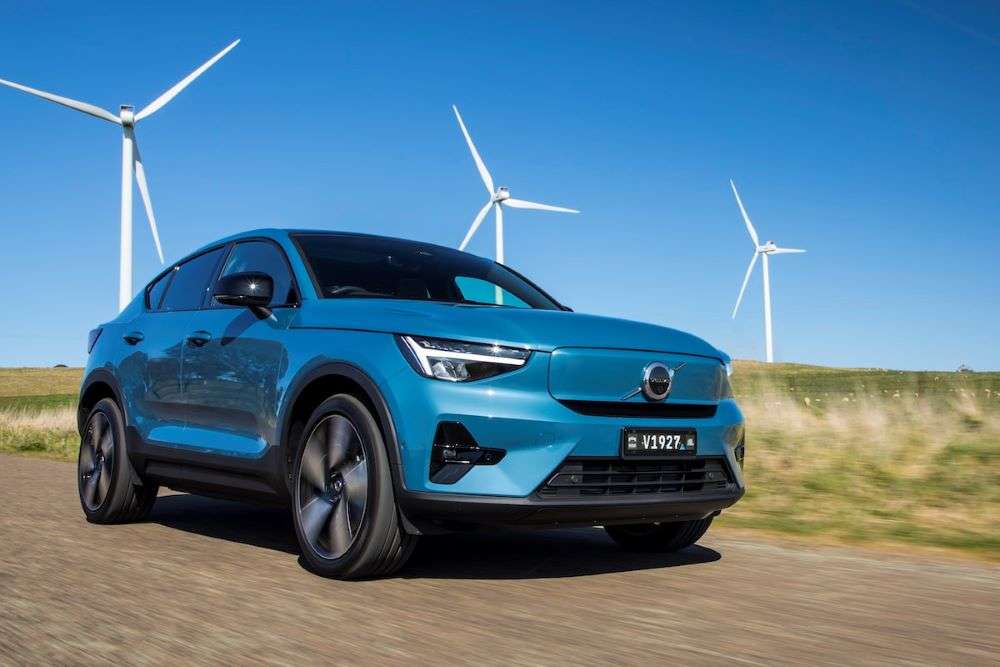
2023 Volvo C40 Recharge Review
Designed solely with electric power in mind, the 2023 C40 Recharge is the latest piece in the puzzle that is Volvo’s quest to be a pure EV brand. It also resurrects a naming convention last attached to a sporty hatchback and prior to that, a coupé.
An array of clever design decisions mean it promises to be faster, offer more range, and to be more environmentally conscious than the XC40 Recharge it shares some of its underpinnings with. We headed to the Adelaide Hills and St Hugo’s in the famed Barossa Valley to check it out.
Range & Price
The 2023 Volvo C40 range is simple with just two variants on offer. For $74,990 (before on-road costs) you can get into the standard Single Motor model. Those after more performance will want to opt for the $82,490 Twin Motor variant.
The motor count isn’t the only thing that changes between them, either, as the Single Motor model uses a smaller 69kWh battery – versus 78kWh for the Twin Motor. The former offers slightly more range at 434km, compared with 420km.
Design
As far as the design is concerned, it’s clear that the C40 is all business up front, while the party is in the back. The familiar face, almost identical to that of the XC40, is offset brilliantly by its sloping roofline that’s accentuated by big haunches on the roof and a distinct rear wing.
That said, it’s this new rear end that adds some of the greatest benefits to this package. Thanks to the noticeable aerodynamic improvements it provides, it shaves 0.2 seconds off the 0-100km/h time compared with the equivalent XC40 models, which use identical drivetrains.
It also increases the range of the Single Motor variant by a claimed 54km.
Check Out The Volvo XC40 Review
Interior
Inside, things look pretty similar to the XC40 Recharge as well, with the same dashboard layout retained here. For the most part, that’s a very good thing – the ergonomics are great, the layout is clean and crisp, and it’s traditional in a good way.
However, the blank switch where the on/off button would be in a petrol XC40 still remains as an unsightly reminder of the past. In both the 2023 Volvo C40 Recharge and XC40 Recharge, you simply hop in and put it in drive to start.
Speaking of which, you only need to pull the C40’s electronic shifter once to slide it into drive. Some other Volvo’s annoyingly require two pulls – one to first enter neutral, and then another to go to drive – so at least that has fortunately been addressed.
The big change inside the C40’s cabin, though, is the array of materials used throughout as traditional leather has been eschewed entirely for the first time in favour of sustainable materials.
The carpets, for instance, are made entirely from recycled plastic, while wool-fibre and Microtech upholstery is used in varying capacities throughout. There’s a new trim design in the top-spec model made from recycled plastic as well.
Its design is based off the topography of Sweden’s Abisko national park. In base models, meanwhile, a monochrome map of Gothenburg adorns these trim panels.
Technology
In terms of tech, the 2023 Volvo C40 uses the Android Automotive system that’s now being rolled out across Volvo’s line-up, with it spread across a 12.0-inch instrument display and central 9.0-inch portrait-oriented touchscreen.
In the case of the latter, you get the benefits of Google Assistant voice control which can be used for a lot of the car’s functions, while you also get easy-to-use Google Maps navigation.
In all models, you also get dual-zone climate control, heated front and rear seats, a heated steering wheel, power-adjusted front seats with memory for the driver, and the usual array of active safety technology you’d expect including the Pilot Assist lane-centring system.
There’s also a big panoramic sunroof as standard, although there’s no cover for it so the sun always shines through. Stepping up to the top-spec model does, in addition, nab you a Harman Kardon premium audio system and 360-degree camera.
It also adds larger 20-inch wheels versus the Single Motor’s 19-inch rims. Additionally, the interior finishes do feel a step up on the top-spec model. But with so many similarities in every other regard, it’s the way the two variants drive that really separates them.
Driving experience
While the base model features only a single 170kW/330Nm motor driving the front wheels, the top-spec model adds in a second motor on the rear axle to deliver a combined 300kW and 660Nm.
The sheer contrast in the 0-100km/h times of the pair – 7.2 seconds for the former, but a mere 4.7 seconds for the latter – serves as a clear indicator as to the way the two are positioned.
With the front-wheel drive model geared toward efficiency, it feels as relaxing to drive as its cabin is to merely be in. It’s at its best on a drive such as the one we were on, meandering through the South Australian countryside in absolute peace and comfort.
While you can certainly still enjoy it in the corners – it handles with quiet confidence and has enough power for most people – the rare torque steer tug at the wheel serves as a reminder that this variant is really the sensible one.
The Twin Motor model is a different beast. Pin the throttle and it’s absolutely rapid in a straight line, while through the corners it feels utterly tractable and planted. It also feels more substantial – I can think of no better word for it – on the road.
You can chalk that up to the extra low-down weight of its bigger battery pack. Both versions of the C40 are similar in that the power delivery is very smooth in both as the throttle feels progressive.
In the Twin Motor the speed simply swells as you wind it up faster rather than falling off once you’re up to triple-digit speeds like some EVs can. The brake pedal feel is fantastic as well, with it feeling far more organic than in many EVs.
The ride quality is very good as well with the C40 soaking up bumps on the tree-lined Adelaide Hills roads with ease, with an audible wince before one unmissable bump being unnecessarily dramatic as it was practically unfelt in the cabin.
Behind the wheel and in the passenger seat, it’s simply ever-pleasant. It’ll take spending more time with one of these to be able to test its range thoroughly, but I did note that the Single Motor car on the return trip to Adelaide still sat a bit above 50 percent battery.
Verdict
We’ve told you the pricing already, but it’s worth noting that additionally, the Twin Motor presents quite a saving compared to the Kia EV6 GT-Line AWD, although the Ioniq 5 Techniq does have it beaten on price.
Do remember though the C40 is noticeably faster than both and certainly feels sportier than the latter. The Single Motor, however, is beaten by the EV6 Air, Ioniq 5 Dynamiq, and Tesla Model Y RWD to the tune of a couple grand, which certainly takes the shine off it.
Given how the C40 sits in terms of pricing, then, I’d say the Twin Motor is clearly the way to go. The level of performance it offers means it’s a car that’s certainly endearing, and the substantial feel it has on the road and in its cabin gives it a definite premium edge.
Read The Review Of Kia EV6 Air And Hyundai Ioniq
This story was first published on Exhaust Notes Australia: https://www.exhaustnotes.com.au/quick-drive-2023-volvo-c40-recharge/
Once you've found the right car, the next step is sorting out car finance that actually works for your budget. Credit One is Australia's best-reviewed finance broker, with 3,000+ five-star Google reviews from customers who've been through the process. Check out Credit One reviews to see what people say, or head straight to the loan repayment calculator to see what the numbers look like.
